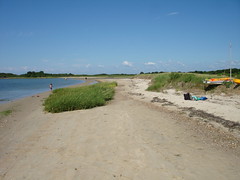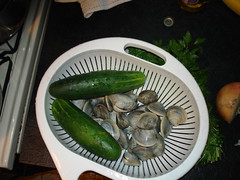The company that put 275 so-called Smart Sponge filters in catch basins in Norwalk almost two years ago says that the devices essentially prevented 1,200 gallons of oil from spilling into Long Island Sound and its tributaries. The company is called AbTech, and it used government funding (400 grand) and the endorsement of the Long Island Soundkeeper to see if its product could keep contaminated stormwater and pollutants out of the Sound. Here's what its press release says: The Filter Project began as a natural outgrowth of the Soundkeeper's mission to protect the Sound's ecosystem coupled with Connecticut's commitment to clean up local waterways. The central component of the strategy involved fitting 275 catch basins in South Norwalk with AbTech Industries' Smart Sponge® Plus filtration system to catch trash, debris, animal waste, hydrocarbons, oil, grease and bacteria before they enter The Sound. The Smart Sponge technology is chemically selective to hydrocarbons, and permanently bonds them within the structure to prevent leaching or leaking of contaminants back into the environment. Once the hydrocarbons are absorbed, the Smart Sponge transforms the pollutants into easily removable solid waste. The system passes the EPA's Toxicity Characteristic Leaching Procedure (TCLP). In addition, the Smart Sponge Plus material used in the stormwater catch basins contained an antimicrobial agent that has proven to be effective against a wide variety of microorganisms. It also acts as a fungi, static, odor, and mildew control.
You can find what I've written about the project here. I of course have no way of knowing independently whether the Smart Sponge is worthwhile. Is preventing 1,200 gallons of oil from reaching the local waterways a good thing? Obviously. Spread over the two-year life of the project, that amounts to 1.6 gallons of oil a day. Since Norwalk is a fairly typical old urban area, that presumably means that an equivalent amount is spilling into waterways from similar urban areas. But it's also a large area physically and when you spread out 1.6 gallons, it's not a large amount.
My question is how do you judge how much better the environmental conditions are in an area where 1,200 gallons of oil has been prevented from reaching local waterways? What other benefits were there? Any evidence that beaches were open more often, or Norwalk's shellfish beds?
So what happens now? Should Norwalk continue the project? Should it expand it and should other communities use the Smart Sponge?
I'm not sure how you can figure out if the SmartSponge is worth the cost. At $400,000 over two years, that's about $1,100 a day. But while results are being announced today, the project might not be over and the filters might still have some life in them, so $1,100 a day is a mximum -- it might be less if they continue to be used.
Unfortunately the AbTech press release, here, doesn't answer the questions. Supposedly there's a press conference today, so maybe some reporters will ask. Senator Joe Libermann is a big supporter. Maybe he knows the answers.
Wednesday update: Judging from the information on my stat counter, I'm fairly sure the Anonymous comment below was left by someone at AbTech, the company that makes the Smart Sponge. A non-anonymous comment from the company would have carried a lot more weight. But let me address it anyway.
My question is not ridiculous at all.
I don't know how much damage is caused by 1,200 gallons of oil spread out over two years in an area as big as a section of the Norwalk Harbor drainage basin. Oil spills in summer are far more harmful that oil spills in winter, for example, so if a fair portion of the 1,200 gallons were to reach the waterways in winter, the damage might not be that great.
Also, Anonymous, you ask: 'If the city rolled out a complete project with the filters can you imagine how much oil it would keep from entering the waterways.'
Actually, no -- I can't imagine. That's what I'm asking! But if I were a Norwalk taxpayer (which I'm not) I'd hope to be given a better idea before I was asked to pay a lot of money for the Smart Sponge.
I'm not saying Smart Sponge is a bad idea. All I'm saying is that it's not completely clear from the press release that the environmental benefit is in any way commensurate with the monetary cost. We know that AbTech says 1,200 gallons of oil were kept from reaching the local waterways over a two-year period. What we don't know is whether there is a meaningful benefit associated with that.
Maybe there is. Or probably there is. But I don't know and AbTech didn't demonstrate it. And to me, it's better to know the answer.
Tuesday, 9/18. So maybe I was wrong in guessing that the anonymous commenter, below, worked for AbTech. Take a look at comment 4. That doesn't change my questions though.Labels: Falcons. Norwalk, Smart Sponge, stormwater pollution







